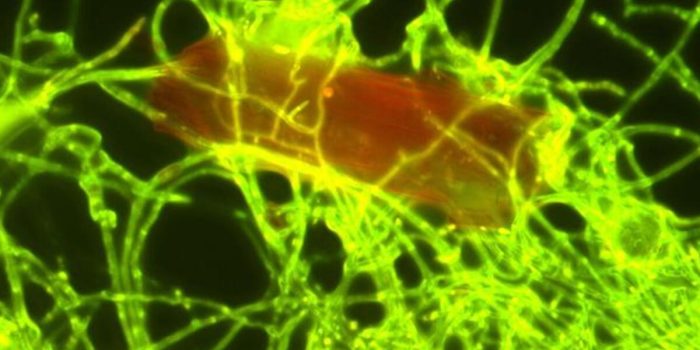The Great Pacific Garbage Patch, also known as the Pacific trash vortex, is a massive collection of marine debris in the North Pacific Ocean, comprising two distinct debris fields bounded by the North Pacific Subtropical Gyre. Scientists recently discovered a marine fungus, Parengyodontium album, within this garbage patch that exhibits the unique ability to break down polyethylene, a common marine plastic pollutant. This finding adds P. album to a small list of fungi capable of degrading plastic, offering a potential biological solution to oceanic plastic pollution.
Researchers isolated P. album from plastic debris collected in the Great Pacific Garbage Patch and tested its plastic-degrading abilities in the laboratory. They exposed polyethylene (PE) to UV radiation to simulate sunlight-induced photodegradation, then observed P. album’s activity over time.
They measured the degradation rate and conversion of polyethylene into carbon dioxide, using advanced techniques such as stable isotope probing assays and nanoSIMS analysis to trace the incorporation of plastic-derived carbon into fungal biomass. The findings confirmed that P. album can degrade polyethylene, providing significant insights into potential solutions for marine plastic pollution.
“What makes this research scientifically outstanding, is that we can quantify the degradation process,” lead author Annika Vaksmaa said in the paper.

Annika Vaksmaa also highlighted the scientific importance of quantifying the degradation process. The team found that P. album degrades PE at a rate of approximately 0.05 percent per day.
Notably, the fungus converts most of the carbon from PE into carbon dioxide, excreting it rather than incorporating it into its biomass. This process requires the plastic to have been exposed to UV light, suggesting that in the ocean, P. album can only degrade plastic floating near the surface.
“Our measurements also showed that the fungus doesn’t use much of the carbon coming from the PE when breaking it down. Most of the PE that P. album uses is converted into carbon dioxide, which the fungus excretes again,” added Vaksmaa.
Alluding to P. album, Vaksmaa explained: “In the lab, P. album only breaks down PE that has been exposed to UV-light at least for a short period of time. That means that in the ocean, the fungus can only degrade plastic that has been floating near the surface initially.”

This discovery represents a crucial step forward in addressing climate change and reducing marine plastic pollution. To date, only four other fungal species have been known to degrade plastic, though several bacteria have been identified with this capability.
Vaksmaa pointed out that large amounts of plastic accumulate in subtropical gyres, with approximately 80 million kilograms of floating plastic in the North Pacific Subtropical Gyre alone, one of six such gyres worldwide.
“Large amounts of plastics end up in subtropical gyres, ring-shaped currents in oceans in which seawater is almost stationary,” stated Vaksmaa.

“That means once the plastic has been carried there, it gets trapped there. Some 80 million kilograms of floating plastic have already accumulated in the North Pacific Subtropical Gyre in the Pacific Ocean alone, which is only one of the six large gyres worldwide.”
The research was conducted by marine microbiologists from the Royal Netherlands Institute for Sea Research (NIOZ), in collaboration with Utrecht University, the Ocean Cleanup Copenhagen, and St. Gallen, Switzerland. The study’s results were published in the journal *Science of The Total Environment*, providing a promising avenue for future efforts to mitigate the global plastic pollution crisis.


